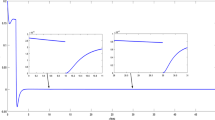Abstract
This paper studies the stochastic robust stability for impulsive interval neural networks with distributed time-varying delays of neutral type. The present model is a more general description of the real world in nature, where both discrete delays and distributed delays are taken into consideration. The parameter uncertainties are assumed to be bounded and laid in a certain interval. By constructing a novel Lyapunov–Krasovskii functional, together with some inequality techniques and stochastic stability theory, some sufficient criteria are driven in terms of linear matrix inequalities (LMI), which are easily to verify and can be solved by MATLAB. Furthermore, the results obtained in this paper are less conservative and cover more situations compared with the ones published in the literature.



Similar content being viewed by others
References
Haykin S (1994) Neural networks: a comprehensive foundation. Prentice-Hall, Englewood Cliffs
Hopfield JJ (1984) Neuron with graded response have collective computational properties like those of two-state neurons. Proc Nat Acad Sci 81(5):3088–3092. doi:10.1073/pnas.81.10.3088
Hopfield JJ (1982) Neural networks and physical systems with emergent collective computational abilities. Proc Nat Acad Sci 79(8):2554–2558
Juang JC (1999) Stability analysis of Hopfield-type neural networks. IEEE Trans Neural Netw 10(6):1366–1374. doi:10.1109/72.809081
Li XL (2008) Exponential robust stability of stochastic interval Hopfield neural networks with time-varying delays. In: Proceedings of the 27th Chinese control conference, pp 701–704. doi: 10.1109/CHICC.2008.4605578
Forti M, Nistri P (2003) On global stability of Hopfield neural networks with discontinuous neuron activations. In: Proceedings of the 2003 international symposium on circuits and systems, pp 478-481. doi:10.1109/ISCAS.2003.1205060
Huang H, Ho DWC, Lam J (2005) Stochastic stability analysis of fuzzy Hopfield neural networks with time-varying delays. IEEE Trans Circuits Syst 52(5):251–255. doi:10.1109/TCSII.2005.846305
Zhang QL, Jia GJ (2007) Impulsive synchronization of typical Hopfield neural networks. In: Proceedings of the 26th Chinese control conference, pp 270–273. doi:10.1109/CHICC.2006.4346890
Zhang K, Lian J, Sun XM, Wang D (2010) Stability of switched Hopfield neural networks with time-varying delay. American control conference, pp 4943–4948
Chua LO, Yang L (1988) Cellular neural networks: theory. IEEE Trans Circuits Syst 35(10):1257–1272. doi:10.1109/31.7600
Baldi P, Atiya AF (1994) How delays affect neural dynamics and learning. IEEE Trans Neural Netw 5(4):612–621. doi:10.1109/72.298231
Li CD, Liao XF, Zhang R (2004) Global robust asymptotical stability of multi-delayed interval neural networks: an LMI approach. Physics Lett A 328(6):452–462. doi:10.1016/j.physleta.2004.06.053
Bainov DD, Simeonov PS (1989) Systems with impulse effect: stability, theory and applications. Ellis Horwood, Chichester
Stamova IM (2009) Stability analysis of impulsive functional differential equations. Walter de Gruyter, Berlin
Stamova IM, Ilarionov R (2010) On global exponential stability for impulsive cellular neural networks with time-varying delays. Comput Math Appl 59(11):3508–3515. doi:10.1016/j.camwa.2010.03.043
Liu B (2008) Stability of solutions of stochastic impulsive systems via comparison approach. IEEE Trans Automat Control 53(9):2128–2133. doi:10.1109/TAC.2008.930185
Li CX, Sun JT, Sun RY (2010) Stability analysis of a class of stochastic differential delay equations with nonlinear impulsive effects. J Franklin Inst 347(7):1186–1198. doi:10.1016/j.jfranklin.2010.04.017
Zhang H, Guan ZH, Feng G (2008) Reliable dissipative control for stochastic impulsive systems. Automatica 44(4):1004–1010. doi:10.1016/j.automatica.2007.08.018
Zhang HG, Dong M, Wang YC, Sun N (2010) Stochastic stability analysis of neutral-type impulsive neural networks with mixed time-varying delays and Markovian jumping. Neurocomputing 73(13–15). doi:10.1016/j.neucom.2010.04.016
Balasubramaniam P, Lakshmanan S, Rakkiyappan R (2009) Delay-interval dependent robust stability criteria for stochastic neural networks with linear fractional uncertainties. Neurocomputing 72(16–18):3675–3682. doi:10.1016/j.neucom.2009.06.006
Morita M (1993) Associative memory with nonmonotone dynamics. Neural Netw 6(1):115–126. doi:10.1016/S0893-6080(05)80076-0
Yoshizawa S, Morita M, Amari S (1993) Capacity of associative memory using a nonmonotonic neuron model. Neural Netw 6(2):167–176. doi:10.1016/0893-6080(93)90014-N
Bernt K (2003) Stochastic differential equations: an introduction with applications. Springer, New York
Sanchez EN, Perez JP (1997) Input-to-state stability (ISS) analysis for dynamic neural networks. Int Conf Neural Netw 2:1139–1143. doi:10.1109/ICNN.1997.616191
Gu K (2000) An integral inequality in the stability problem of time-delay systems. In: Proceedings of 39th IEEE conference on decision and control, vol 3, pp 2805–2810. doi:10.1109/CDC.2000.914233
Boyd S, El Ghaoui L, Feron E, Balakrishnan V (1994) Linear matrix inequalities in system and control theory. SIAM Studies in Applied Mathematics, SIAM, Philadelphia
Huang LR, Mao XR (2009) Delay-dependent exponential stability of neutral, stochastic delay systems. IEEE Trans Automat Control 54(1):147–152. doi:10.1109/TAC.2008.2007178
Zhang Y, He Y, Wu M (2009) Delay-dependent robust stability for uncertain, stochastic systems with interval time-varying delay. Acta Automatica Sinica 35(5):577–582. doi:10.1016/S1874-1029(08)60088-9
Li XD (2010) Global robust stability for stochastic interval neural networks with continuously distributed delays of neutral type. Appl Math Comput 215(12):4370–4384. doi:10.1016/j.amc.2009.12.068
Acknowledgments
This work was partially supported by the Fundamental Research Funds for the Central Universities of China (Project No. CDJXS11180011 and CDJZR10185501) and the National Natural Science Foundation of China (Grant No. 60974020).
Author information
Authors and Affiliations
Corresponding author
Rights and permissions
About this article
Cite this article
Hu, W., Li, C. & Wu, S. Stochastic robust stability for neutral-type impulsive interval neural networks with distributed time-varying delays. Neural Comput & Applic 21, 1947–1960 (2012). https://doi.org/10.1007/s00521-011-0598-2
Received:
Accepted:
Published:
Issue Date:
DOI: https://doi.org/10.1007/s00521-011-0598-2




